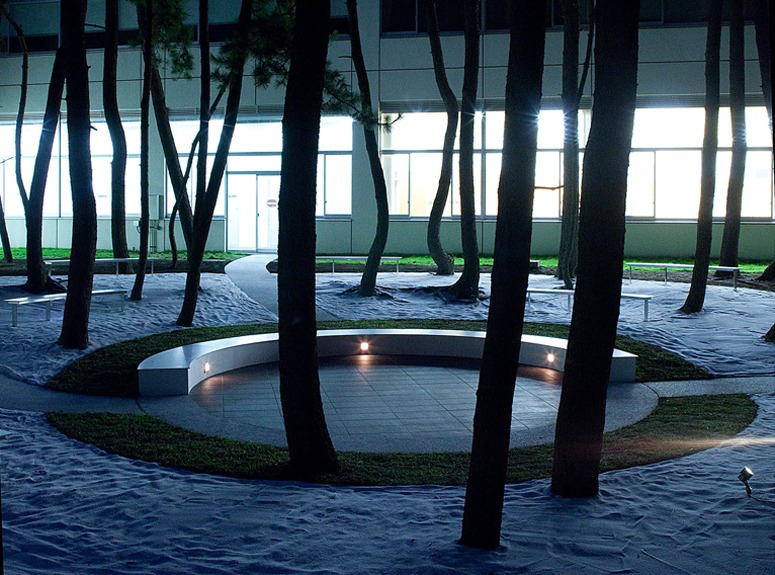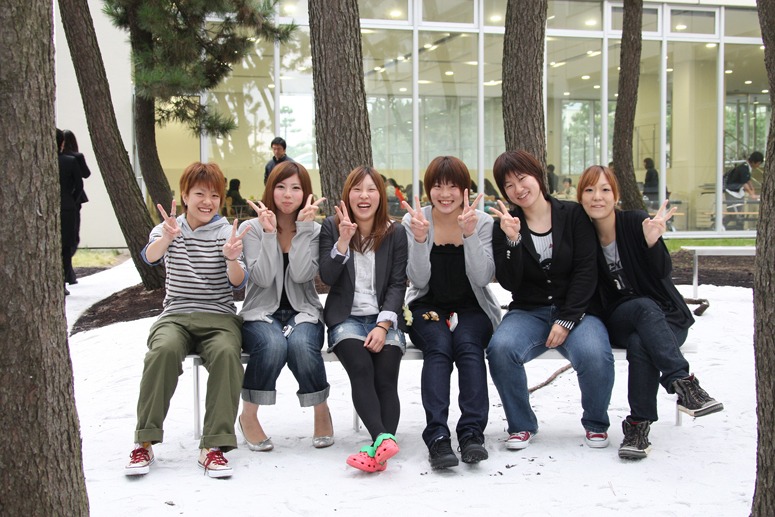 Japan was the first Asian country to modernise its industry but always wanted to retain its unique identity. This turned out to be more difficult for buildings than for gardens. Haruko Seki is a Japanese landscape architect based in London. Perhaps for this reason, she has a keen eye for something essentially Japanese which is not sentimentaly ‘Old Japan’ We saw this in her Silver Moonlight Garden at the 2008 Chelsea Flower Show and are pleased to see it again in the above photograph of the Garden of Pine Woods for Niigata Seiryo University Campus, Niigata City, Japan (completed 2010). The courtyard was designed to become a central event stage and a space where everyone can meet. The structural form gleams softly through the shadow of pines, reflecting and enhancing their beauty. There is a Wabi-Sabi combination of purity with imperfection, because the trees do not allow perfectly complete circles. Sitting beneath the colling shade of pine trees is a pleasant activity in the hot humid shade of a Japanese summer. It is a context-sensitive design, functionally, climatically, culturally and aesthetically. The V-sign is also a context-sensitive gesture. In England it symbolises vulgar aggression (with the palm facing backwards) and victory, as in the Churchill salute, with the palm facing forwards. In Japan and much of East Asia, it became associated with peace and happiness, after the 1972 Olympic Games.
Japan was the first Asian country to modernise its industry but always wanted to retain its unique identity. This turned out to be more difficult for buildings than for gardens. Haruko Seki is a Japanese landscape architect based in London. Perhaps for this reason, she has a keen eye for something essentially Japanese which is not sentimentaly ‘Old Japan’ We saw this in her Silver Moonlight Garden at the 2008 Chelsea Flower Show and are pleased to see it again in the above photograph of the Garden of Pine Woods for Niigata Seiryo University Campus, Niigata City, Japan (completed 2010). The courtyard was designed to become a central event stage and a space where everyone can meet. The structural form gleams softly through the shadow of pines, reflecting and enhancing their beauty. There is a Wabi-Sabi combination of purity with imperfection, because the trees do not allow perfectly complete circles. Sitting beneath the colling shade of pine trees is a pleasant activity in the hot humid shade of a Japanese summer. It is a context-sensitive design, functionally, climatically, culturally and aesthetically. The V-sign is also a context-sensitive gesture. In England it symbolises vulgar aggression (with the palm facing backwards) and victory, as in the Churchill salute, with the palm facing forwards. In Japan and much of East Asia, it became associated with peace and happiness, after the 1972 Olympic Games.

Images and information on Garden of Pine Woods for Niigata Seiryo University

Congratulations to SANAA for taking out the Pritzker Architecture Prize for 2010.
[ http://www.nytimes.com/2010/03/29/arts/design/29pritzker.html ]
Tom do you know who won the Pritzker Landscape Prize? Or did SANAA take that award too for the Serpentine Gallery? Perhaps Haruko Seki will take the Landscape Pritzer in 2011. (Tom the Japanese girls in the photograph are obviously avid followers of yourself having adopted red hairstyles all!)
Not sure, but I do not think there is a Pritzker prize for landscape architecture. Nor do I think my hair is red or reddish. It used to be blond but is pretty thin and mousey these days.
No I don’t think there a Pritzker Prize for Landscape either…Perhaps the Pritzer family will run an inaugural prize in 2011? Afterall Luis Barrigan considered himself a landscape architect…[ http://www.pritzkerprize.com/laureates/1980/bio.html ]
Not sure why I thought you had red hair? [ http://www.gardenvisit.com/blog/2009/04/10/landscape-and-garden-interpretation/ ] I guess I wasn’t very observant.
Here are some context-sensitive questions for Yuan: am I right that the girls’ clothes indicate that they are not Chinese; could you tell that their faces are not Chinese; could you tell whether they are Korean or Japanese?
Re Tom, I am sorry that their clothes may not be the main evidnece for their nationality. They are not Chinese. I judge their nationality according to their eyes.
I have heard that before but have not yet learned to recognize the differences between Chinese and Japanese eyes. Are Korean eyes, as I have heard Korean gardens described, half-Chinese and half-Japanese?
Yes, you are right from my personal experience. I have Chinese and Korean friends.
What about those pink Crocs with green frills – are they popular in China?
Do you mean the shoes? They are common in China and always have different kinds of colour. Many girls like this style even though I think it is not elegant enough.
Yes, I meant the shoes. I asked a Japanese person about the easiest visual way to tell the difference between Chinese and Japanese people and the answer was ‘clothes’, so I am trying to learn about them.
I will tell you a good way which is to see their skin. It does work very well to distinguish male. Korean male’s skin is whiter than Chinese ones’.